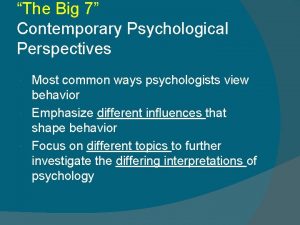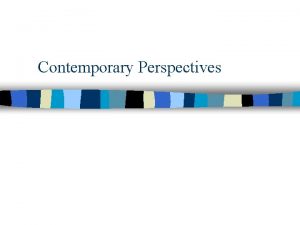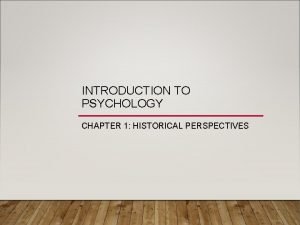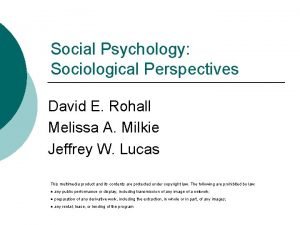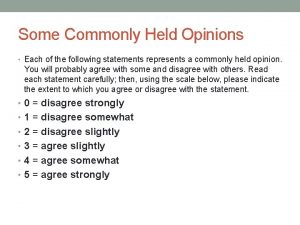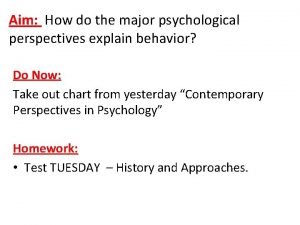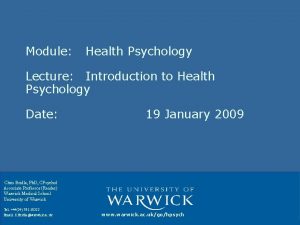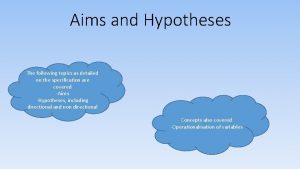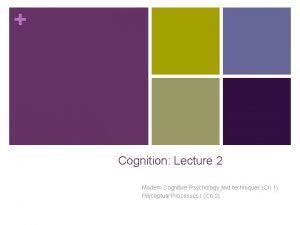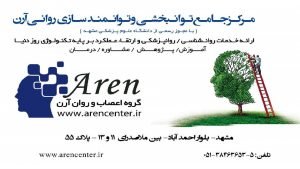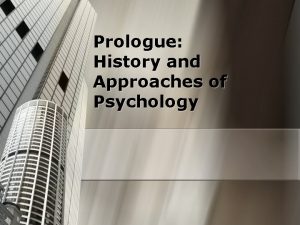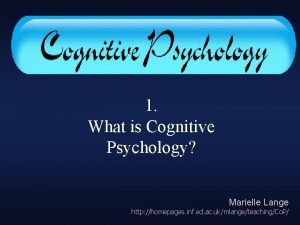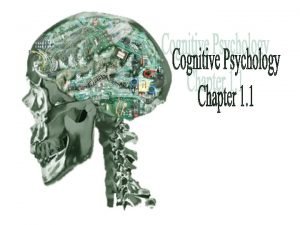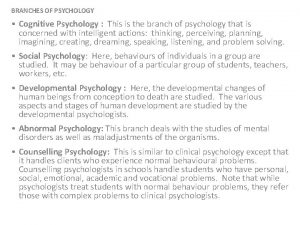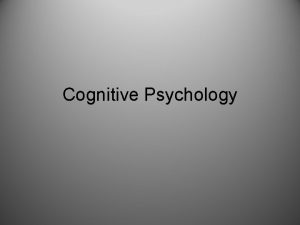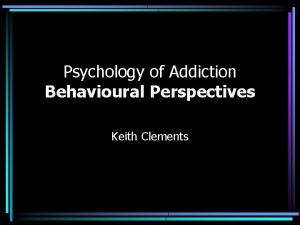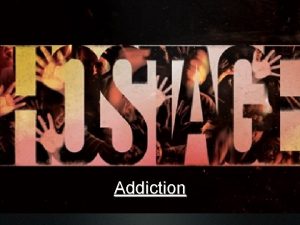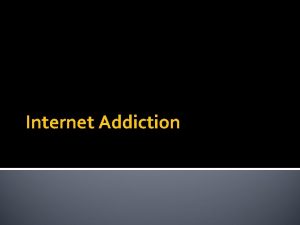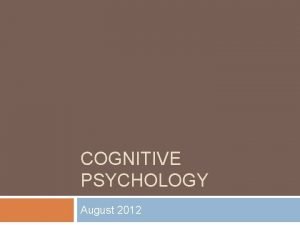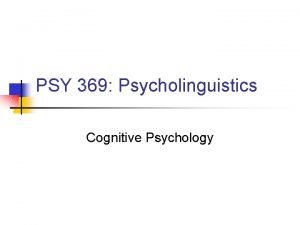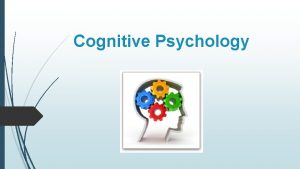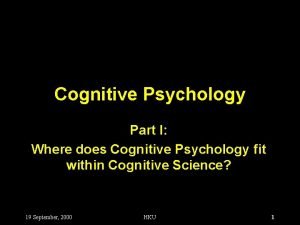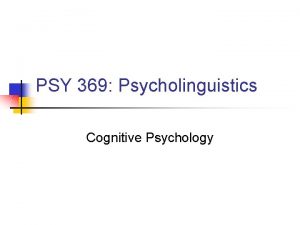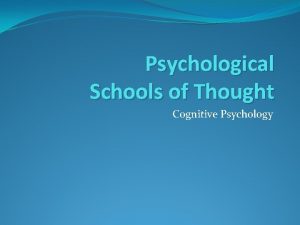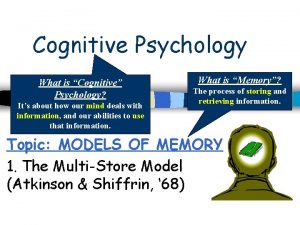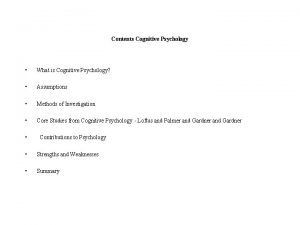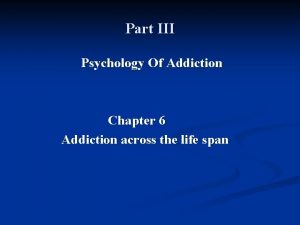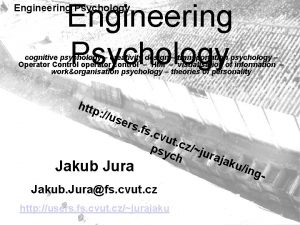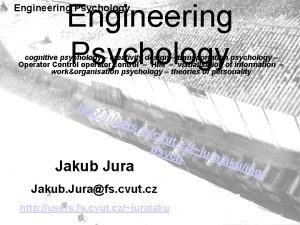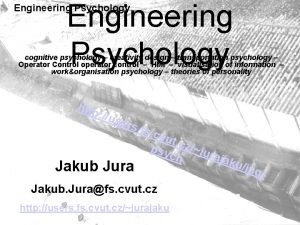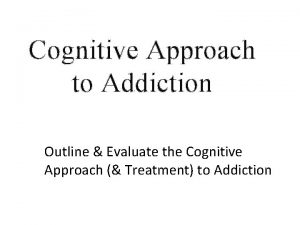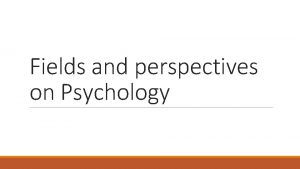Psychology of Addiction Cognitive Perspectives Aims n n























- Slides: 23

Psychology of Addiction Cognitive Perspectives

Aims n n n To examine the role of expectancies and related constructs as influences on the use and abuse of alcohol. To examine applications of cognitive and social learning accounts to treatment of drug and alcohol problems and relapse prevention. To discuss the role of memory processes and implicit cognition in addiction.

Expectancies Alcohol effect expectancies are acquired before regular consumption (Christiansen et al, 1982) Expectancies correlate with use and abuse (Goldman et al, 1987). Positive expectancies are more reliable predictors of use than negative expectancies (e. g. Fromme et al, 1997). Expectancies may be influenced by social stereotypes, vicarious learning & direct experience.

Expectancies Alcohol Marijuana Cocaine Global positive effect Social/Physical Sexual enhancement Arousal/Power/Aggres sion Increased social assertiveness Relaxation/Tension reduction Cognitive & behavioural Impairment Relaxation & tension reduction Social & sexual facilitation Perceptual & cognitive enhancement Global negative effects Craving & physical effects Global positive effects Global negative effects Generalised arousal Anxiety Relaxation & tension reduction Table from Jung (2001, page 169)

Reasons for drinking Expectancies are distinct from reasons for drinking In relation to alcohol use the distinction between negative reinforcement or escape drinking & positive reinforcement or social drinking is important (Farber et al, 1980) We’ll discuss whether alcohol does relieve tension or anxiety in a later session. Drug use correlates with negative affect and psychological disorders, but the direction of causality is unclear.

Reasons for smoking n n Positive Affect Indulgent Stimulant Negative Affect Sedative

Reasons for smoking n Addictive n n n Habitual Dependent Automatic n n Hand/Mouth Activity Psychological Image

Social Learning theory Cooper, Russell & George, 1988 n n n Proposed that expectancies interact with general coping skills. These together predict using alcohol to cope. Using alcohol to cope, together with positive outcome expectancies predict heavy drinking.

Social Learning model Positive Expectancies Heavy Use Coping Skills Drinking to Cope Based on Cooper, Russell & George, 1988 Abuse / Dependence

Self-efficacy Includes n Use self-efficacy n Refusal self-efficacy Morawska & Oei (2005) Alcohol expectancies (AE) interacted with refusal selfefficacy (RSE) to predict binge drinking in students. Predicted high AE & moderate RSE= binge drinkers Moderate AE & High DRSE =Social drinkers High AE & low RSE= Heavy drinkers

COGNITIVE BEHAVIOURAL THERAPIES Behavioural Self-Control Training (Miller et al. , 1992) Aims to replace automatic with controlled processing and includes: n n n Self Monitoring Goal Setting Stimulus control Response (or rate) Control Self-Reward & Self-Punishment Often include social skills training, covering general and specific skills. n Coping skills n Drink-refusal skills n Managing negative moods n Coping with urges to drink

RELAPSE PREVENTION Marlatt & Gordon (1985) Relapse begins with a high-risk situation n n withdrawal stressful situations Relapse depends on n The availability of non-drug coping strategies Self-efficacy positive outcome expectancies following use There is, as yet, little evidence as to the effectiveness of relapse prevention.

The relapse process High-risk situation Coping response No coping response Decreased selfefficacy Positive outcome expectancy After Marlatt & Gordon, 1985 Increased selfefficacy Use (Lapse) Relapse less likely Abstinence Relapse Violation more Effect likely

The abstinence violation effect A single lapse may damage self-efficacy and further weaken an individual’s ability to resist temptation. Similar to Cognitive Dissonance. Several other characteristics of addicts could be explained in terms of the conflict they experience.

Relapse prevention includes a variety of components n n n n Self-monitoring of high-risk situations Rehearsing positive self-statements Distraction Reviewing the pros and cons of abstinence/relapse Covert modelling of coping with high-risk situations Preparation for dealing with lapses Graded practice/exposure

Allsop et al. (1997) Compared: n Relapse prevention with modelling, role play & homework n Discussion about relapse with no practical component n A no treatment control group. Number of weeks abstinent in 6 months Relapse prevention 16 Discussion 9. 8 Control 8. 4 Percent abstinent at 6 months 40% 5% 5% However, there were no significant differences at 12 months follow-up

Implicit Cognition Recent theories emphasise the role of memory processes in addiction. Through experience outcome expectancies and associated behaviours become more accessible. Stacy, Leigh & Weingardt (1994) all participants were able to identify alcohol outcomes, irrespective of drinking frequency. Frequency predicted how often alcohol consumption was identified as a possible behavioural cause of those outcomes.

Implicit Cognition This approach argues that motivation is influenced by the accessibility of positive outcomes. Cues may also activate mental schemas linking outcomes and behaviour. Stacy (1997) showed that past use and measures of memory association predicted marijuana use. Both memory activation and expectancy measures predicted alcohol use.

Urges or cravings are often viewed as emotional states. Different theories may emphasise drug-like or withdrawal-like states. Specific theories will be considered later in the course. Tiffany (1990) Reviewed studies Average correlation between n Physiological changes and reported craving 0. 38 n Measures of consumption and reported craving 0. 40

A cognitive perspective on impaired control Tiffany (1990) presented a model explaining drug use urges in cognitive terms. Drug use can become automatic, triggered by environmental stimuli independently of conscious intentions. Drug urges are defined as effortful controlled processing. Controlled processing might be invoked when non-abstinent users need to overcome barriers which have disrupted automatic patterns of use or when abstinent users attempt to prevent automatically-triggered consumption. Tiffany suggests that factors such as negative moods may trigger relapse by reducing cognitive resources, rather than directly motivating drug use.

Evidence consistent with these approaches Gross, Jarvik & Rosenblatt (1993) showed that abstinent smokers were slower to name the colours of smoking related words. Non-abstinent smokers were faster for smoking words, presumably because they were more familiar Hillebrand (2000) presented abstinent opiate users with verbal drug cues, neutral stimuli or a negative mood induction procedure. The drug cue produced greater craving and also slowed performance on a secondary reaction time task.

Further Reading Teeson, Degenhardt and Hall discuss cognitive therapy for alcoholism in chapter five. They discuss CBT for cannabis dependence and relapse prevention in chapter seven. There’s a good review of Marlatt’s cognitive-behavioural model at http: //pubs. niaaa. nih. gov/publications/arh 23 -2/151160. pdf The Tiffany (1990) article is reprinted in Hyman, S. Ed. (2001) The science of mental health Vol. 5 : Addiction. - New York; Routledge

Articles mentioned in the lecture Allsop, S, Saunders, B, Phillips, M & Carr, A (1997). A trial of relapse prevention with severely dependent male problem drinkers Addiction, 92, 61 -74 Cooper, ML, Russell, M & George, WH (1988). Coping, expectancies and alcohol abuse, a test of social learning formulations. Journal of Abnormal Psychology, 97, 218 -230. Marlatt GA & Gordon JR (1985). Relapse Prevention. New York, Guilford Stacy, A (1997). Memory Activation and Expectancy as Prospective Predictors of Alcohol and Marijuana Use. Journal of Abnormal Psychology, 106, 61 -73.
 Cognitive and non cognitive religious language
Cognitive and non cognitive religious language 7 perspectives of psychology
7 perspectives of psychology 7 perspectives of psychology
7 perspectives of psychology 7 major perspectives in psychology
7 major perspectives in psychology Contemporary perspective
Contemporary perspective Contemporary perspective definition
Contemporary perspective definition Historical perspectives of psychology
Historical perspectives of psychology Social psychology sociological perspectives
Social psychology sociological perspectives Psychology perspectives
Psychology perspectives Major perspectives in psychology
Major perspectives in psychology Hand mnemonic for the 7 perspectives of psychology
Hand mnemonic for the 7 perspectives of psychology Four major perspectives of psychology
Four major perspectives of psychology 5 major perspectives in psychology
5 major perspectives in psychology Definition of health psychology
Definition of health psychology What is a directional hypothesis in psychology
What is a directional hypothesis in psychology Bottom up processing example
Bottom up processing example Cognitive psychology ppt
Cognitive psychology ppt Cognitive psychology crash course
Cognitive psychology crash course 5 major domains of psychology
5 major domains of psychology Token economy in psychology
Token economy in psychology History of cognitive psychology
History of cognitive psychology Emphasis
Emphasis Branches of psychology
Branches of psychology Cognitive model psychology
Cognitive model psychology

